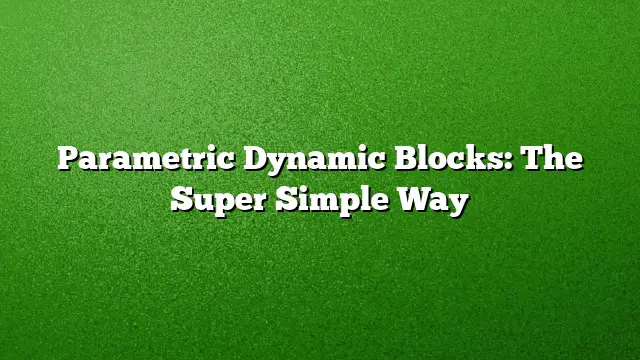Understanding Parametric Dynamic Blocks in AutoCAD 2025
Creating highly adaptable designs and models is essential in modern drafting, and AutoCAD 2025 offers powerful tools to enhance your productivity through parametric dynamic blocks. These blocks allow users to create objects that can adjust and modify based on certain parameters, improving efficiency and flexibility. This guide will break down the steps to creating and utilizing parametric dynamic blocks effectively.
What are Parametric Dynamic Blocks?
Parametric dynamic blocks combine the features of standard blocks and parametric constraints. They enable designers to create a single block that can adjust its shape, size, and configuration according to specified parameters. Instead of using multiple static blocks, a single dynamic block can serve various purposes, making it easier to manage and modify designs.
Setting Up Your Workspace
Before diving into the creation of dynamic blocks, ensure your AutoCAD 2025 workspace is prepared for optimal performance.
- Open AutoCAD 2025.
- Set the appropriate workspace by selecting
Drafting & Annotationor another preferred setup from the top-right corner. - Familiarize yourself with the tool palette, where you will access blocks, parameters, and constraints.
Creating a Basic Dynamic Block
To create a dynamic block, follow these steps:
- Draw the Base Geometry:
- Use drawing tools (lines, circles, rectangles) to outline the basic shape of your block. For instance, if designing a door, sketch the outline of the door frame.
- Define the Block:
- Select the geometry you just created, then right-click and choose
Block > Create Block. - Name your block and choose a base point (this point will serve as the insertion point).
- Select the geometry you just created, then right-click and choose
- Add Parameters:
- Access the
Block Editorby typingBEDITin the command line. This opens a dedicated area for editing the block. - Use the
Parameterstab to add parameters that will dictate how the block behaves. For example, you can add a linear parameter for the width and height of the door.
- Access the
- Insert Action:
- After defining parameters, insert actions that link to these parameters. Click on the
Actionpanel, select an appropriate action likeStretchorScale, and then select the parameter associated with it. - Click on the objects that will change in response to user actions.
- After defining parameters, insert actions that link to these parameters. Click on the
- Test the Block:
- Save the changes and exit the Block Editor. Insert your block in the drawing area to ensure the dynamic features work as intended. Test various adjustments to see how the block responds to the parameters.
Applying Advanced Features
Once you are comfortable with creating basic dynamic blocks, explore advanced options for even greater flexibility.
- Adding Multiple Actions:
- Dynamic blocks can perform several actions based on different parameters. Combine actions such as rotation and scaling to create more complex designs.
- Visibility States:
- Create visibility states to show different configurations or options for the block. For example, a block representing different types of doors can have states for open and closed.
- Use the
Visibilityparameter and create distinct visibility states through the Block Editor.
- Creating Nested Blocks:
- For more complex designs, you can nest dynamic blocks inside one another. This involves creating a block that contains other blocks, allowing layers of complexity while maintaining a single dynamic interface.
Best Practices for Dynamic Blocks
- Organize Parameters and Actions: Maintain a logical naming convention for parameters and actions. This will simplify future modifications and improve readability for users who might work with your blocks later.
- Documentation: Keep a record of how each block functions, including its parameters and potential uses. This can be especially helpful for teams working collaboratively.
- Test Thoroughly: Validate that the block behaves correctly under all intended scenarios. This helps avoid unexpected issues in larger projects.
Frequently Asked Questions
1. How do I modify an existing dynamic block?
To modify an existing dynamic block, use the BEDIT command to enter the Block Editor, make the changes to your geometry, parameters, or actions, then save your updates.
2. Can I convert regular blocks into dynamic blocks?
Yes, you can convert regular blocks into dynamic blocks by editing them in the Block Editor and adding the necessary parameters and actions.
3. What advantages do dynamic blocks offer over standard blocks?
Dynamic blocks offer greater flexibility as they can adapt to different configurations and dimensions without needing multiple static blocks. This reduces clutter in the drawing and simplifies modifications.

